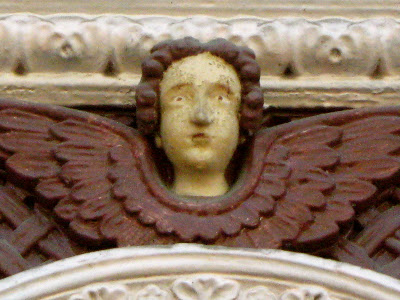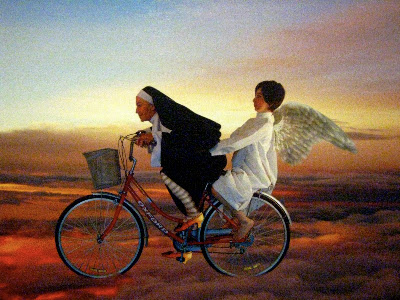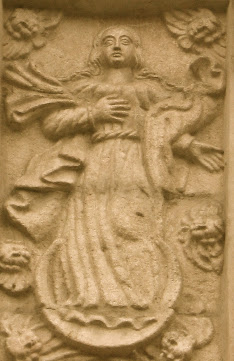Ecuador, being a Catholic country, has an abundant supply of angels; near or built into churches, on the road side in small shrines, decorating buildings and in artwork.
The theological study of angels is known as angelology. In art, angels are often depicted with wings; perhaps reflecting the descriptions in Revelation 4:6-8 and the descriptions in the Hebrew Bible -- of cherubim and seraphim (the chayot in Ezekiel's Merkabah vision and the Seraphim of Isaiah). However, while cherubim and seraphim have wings in the Bible, no angel is mentioned as having wings.
Early Christians inherited Jewish understandings of angels, which in turn may have been partly inherited from the Egyptians. In the early stages, the Christian concept of an angel characterized the angel as a messenger of God.
The earliest known Christian image of an angel—in the Cubicolo dell'Annunziazione in the Catacomb of Priscilla (mid-third century)—is without wings. In that same period, representations of angels on sarcophagi, lamps and reliquaries also show them without wings. The earliest known representation of angels with wings is on the "Prince's Sarcophagus", discovered in the 1930s at Sarigüzel, near Istanbul, and attributed to the time of Theodosius I (379-395). From that period on, Christian art has represented angels mostly with wings.
This whimsical picture of an angel riding behind a nun on a bicycle and (a bit lower) the angel contemplating itself in a mirror were both done by the Ecuadorian artist Catalina Carrasco. We snapped the pictures at Cuenca's Museum of Modern Art.
In terms of their clothing, angels, especially the Archangel Michael, were depicted as military-style agents of God and came to be shown wearing late antique military uniforms. The basic military dress was shown in Western art into the Baroque period and beyond and up to the present day in Eastern Orthodox icons. Other angels came to be conventionally depicted in long robes, and in the later Middle Ages they often wear the vestments of a deacon.
A putto (plural putti) is a figure of a human baby or toddler, almost always male, often naked and having wings, found especially in Italian Renaissance and Baroque art. The figure derives from ancient art but was rediscovered in the early Quattrocento. Putti are distinct from cherubim, but some English-speakers confuse them with each other, except that in the plural, "the Cherubim" refers to the biblical angels, while "cherubs" is used more often to refer to the child-like representations or in figurative senses. Putti are allegorical, non-literal figures, and later in Christian art came to represent the omnipresence of God.
A cherub is a type of spiritual being mentioned in the Bible, usually associated with the presence of God.
Cherubim are also mentioned in the Torah. The prophet Ezekiel describes cherubim as a tetrad of living creatures, each having four faces: of a man, a lion, an ox, and an eagle. They are said to have the stature and hands of a man, feet of a calf, and four wings each. Two of the wings extended upward, meeting above and sustaining the throne of God; while the other two stretched downward and covered the creatures themselves.
This picture was snapped near the church at Turi (a small suburb just outside of Cuenca). It was then put through an antiquing process.

Angels have appeared in works of art for millennia. Angel-shaped beings appear in ancient Mesopotamian and Greek art. Angels remained a popular subject for Byzantine and European paintings and sculpture. Angels have also become an integral part of Anime culture, particularly in fan art and webcomics.
Here in Ecuador angels watch us constantly.
Click here to see more pictures of Ecuador's Angels & Crosses









0 comments:
Post a Comment